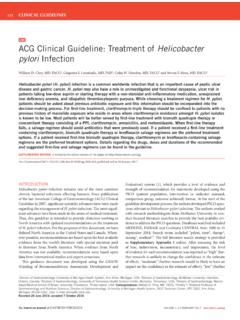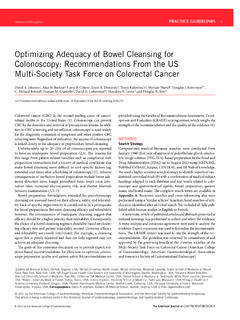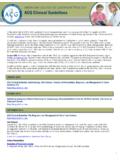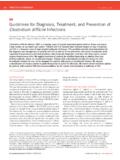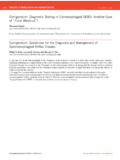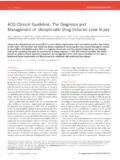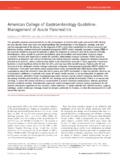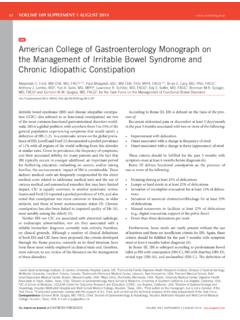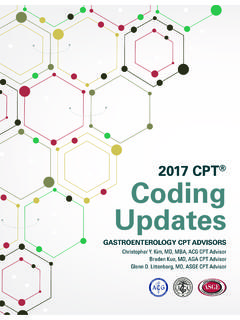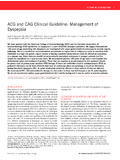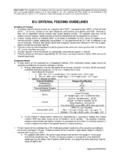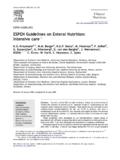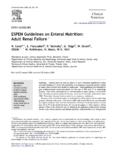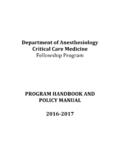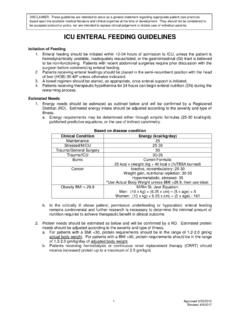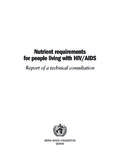Transcription of ACG Clinical Guideline: Nutrition Therapy in the Adult ...
1 Nature publishing group1 2016 by the American College of Gastroenterology The American Journal of GASTROENTEROLOGYPRACTICE guidelines INTRODUCTION Th e modern era of Clinical Nutrition began with the develop-ment of total parenteral Nutrition (PN) by Dudrick ( 1 ) in 1966, suggesting for the fi rst time that clinicians could compensate for intestinal failure with the potential to supply nutrients to any hospitalized patient. Further support for the unique contribution of PN came from a paper entitled Th e Skeleton in the Hospital Closet by Butterworth ( 2 ), which indicated that nearly 50% of patients in an urban hospital setting (in the United States) were malnourished. Th e response to these innovative concepts spurred the growth of Nutrition support teams and PN-based Therapy over the next two decades with the primary objective being to maintain lean body mass, achieve nitrogen balance, and prevent malnutri-tion ( 3 ).
2 Over this time period, however, randomized controlled trials (RCTs) showed little outcome eff ect from the use of PN compared with standard Therapy (where patients are managed with intravenous (IV) fl uids, no enteral or parenteral Therapy , and advancement to oral diet as tolerated) ( 4,5 ). Meta-analyses showed that, outside the setting of intestinal failure, in the absence of severe malnutrition, PN had little eff ect on Clinical outcomes and actually had the potential to cause net harm ( 6 ). In the 1990s, a paradigm shift ensued toward enteral Nutrition (EN)-based Therapy , with the goal changing as well to maintaining gut integ-rity, providing immune modulation, and downregulating infl am-matory responses ( 3 ). Early meta-analyses showed that EN was both superior to PN-based Therapy and more eff ective in improv-ing outcome than standard Therapy ( 4,7,8 ).
3 Lately, challenges to the practice of Clinical Nutrition have occurred in response to the introduction of immune- and metabolic-modulating Nutrition Therapy , the evolving epidemic of obesity in the United States, and recent Clinical trials suggesting that short-term (4 7 days) low-dose trophic feeding (aka, permissive underfeeding or hypo-caloric feeding) might be equally as eff ective as full feeding for the fi rst week of hospitalization ( 9 11 ). Furthermore, in an era of ACG Clinical Guideline: Nutrition Therapy in the Adult Hospitalized Patient S t e p h e n A . M c C l a v e , M D 1 , J o h n K . D i B a i s e , M D , F A C G 2 , Gerard E. Mullin , MD, FACG 3 and Robert G.
4 Martindale , MD, PhD 4 The value of Nutrition Therapy for the Adult hospitalized patient is derived from the outcome benefi ts achieved by the delivery of early enteral feeding. Nutritional assessment should identify those patients at high nutritional risk, determined by both disease severity and nutritional status. For such patients if they are unable to maintain volitional intake, enteral access should be attained and enteral Nutrition (EN) initiated within 24 48 h of admission. Orogastric or nasogastric feeding is most appropriate when starting EN, switching to post-pyloric or deep jejunal feeding only in those patients who are intolerant of gastric feeds or at high risk for aspiration. Percutaneous access should be used for those patients anticipated to require EN for >4 weeks.
5 Patients receiving EN should be monitored for risk of aspiration, tolerance, and adequacy of feeding (determined by percent of goal calories and protein delivered). Intentional permissive underfeeding (and even trophic feeding) is appropriate temporarily for certain subsets of hospitalized patients. Although a standard polymeric formula should be used routinely in most patients, an immune-modulating formula (with arginine and fi sh oil) should be reserved for patients who have had major surgery in a surgical ICU setting. Adequacy of Nutrition Therapy is enhanced by establishing nurse-driven enteral feeding protocols, increasing delivery by volume-based or top-down feeding strategies, minimizing interruptions, and eliminating the practice of gastric residual volumes. Parenteral Nutrition should be used in patients at high nutritional risk when EN is not feasible or after the fi rst week of hospitalization if EN is not suffi cient.
6 Because of their knowledge base and skill set, the gastroenterologist endoscopist is an asset to the Nutrition Support Team and should participate in providing optimal Nutrition Therapy to the hospitalized Adult patient. Am J Gastroenterol advance online publication, 8 March 2016; doi: 1 Department of Medicine, Division of Gastroenterology, Hepatology, and Nutrition , University of Louisville School of Medicine , Louisville , Kentucky , USA ; 2 Department of Medicine, Mayo Clinic , Scottsdale , Arizona , USA ; 3 Department of Medicine, Johns Hopkins University , Baltimore , Maryland , USA ; 4 Department of Surgery, Oregon Health Sciences University , Portland , Oregon , USA . Correspondence: Stephen A. McClave, MD, Department of Medicine, Division of Gastroenterology, Hepatology, and Nutrition , University of Louisville School of Medicine , 550S, Jackson St , Louisville , Kentucky 40202 , USA.
7 E-mail: McClave et al. The American Journal of GASTROENTEROLOGY VOLUME XXX | XXX 2016 2moderate glucose control, better care of central lines, protocolized management of risk, and avoidance of overfeeding, the outcome benefi ts of PN may be approaching that of EN ( 12 ). Support for the benefi t of EN-based Therapy on clinically impor-tant outcomes is derived from fi ve distinct bodies of research in the literature. Multiple RCTs comparing early vs. delayed EN suggest that feedings started within the fi rst 24 to 36 h of admission to the intensive care unit (ICU) are associated with signifi cantly reduced infection, hospital length of stay, and mortality compared with feed-ings started aft er that time point ( 13 15 ). RCTs comparing early EN vs. standard Therapy (in elective surgery, surgical critical care, and patients being operated on for complications of pancreatitis) showed a signifi cant correlation between enteral feeding initiated the day aft er the operation and reductions in infection, hospital length of stay, and mortality ( 8,16,17 ).
8 Observational data from fi ve prospective trials suggest that an increasing caloric defi cit (cre-ated by daily patient energy expenditure and delays in delivery of Nutrition Therapy ) is associated with signifi cant increases in organ failure, hospital length of stay, infectious morbidity, and total com-plications ( 18,19 ). Nutrition Therapy designed to reduce the caloric defi cit has been associated with improved outcomes, as shown by signifi cant reductions in infection and mortality ( 20 ). Th e positive impact of nurse-driven protocols, which serve to increase deliv-ery of EN, has been demonstrated in RCTs and prospective trials (before and aft er implementation of the protocol), where the use of such strategy has been associated with subsequent reductions in infection, hospital length of stay, and mortality compared with non-protocolized Therapy ( 21,22 ).
9 Finally, three decades of mecha-nistic data in animal models and Clinical studies show that early EN helps maintain gut integrity, supports the role of commensal bacteria, reduces the gut/lung axis of infl ammation, sustains the mass of gut-associated and mucosal-associated lymphoid tissue, and attenuates systemic infl ammatory responses ( 23 ). Although the intended target patient population of these guide-lines is the hospitalized patient, most of the information on pro-viding Nutrition Therapy is derived from the management of patients in the ICU. Every hospitalized patient has a unique meta-bolic/immune response to surgery, illness, or injury, which may be modulated or attenuated by appropriate Nutrition Therapy ( 24 ). As a result, Nutrition Therapy has emerged as a primary therapeutic intervention.
10 Th e degree to which a patient benefi ts from Nutrition Therapy depends on disease severity, baseline nutritional status, and design of the Nutrition regimen itself ( 24 ). Th e timing, route, content, delivery, and patient tolerance are all variables that infl uence the potential for those benefi ts. Successful Nutrition Therapy depends on the appropriate assessment of gut function, achievement of enteral access, the creation of protocols to standar-dize delivery, and an ongoing process to monitor tolerance. METHODOLOGY A list of questions and recommendations were compiled by the group of experts on the guideline committee. A literature search was performed using Embase, Pubmed, MEDLine, Cochrane Database, Google search for scholarly articles, and personal fi les of committee members.
